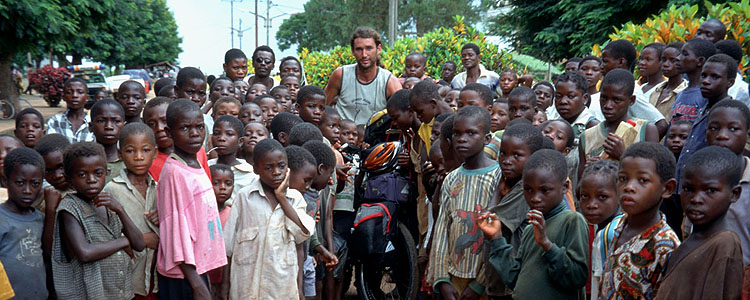With a little cold and rain, I remained in Gurue for three days, picking up information for my next destination: the Mount Namuli, and to know then, as they told me, where the white man doesn’t reach.
In the county of Zambezia I finally arrived to Gurue, a small city that, as its mountainous surroundings, is different of the rest of the country because its temperature is not so hot.
Quickly I was surrounded by dozens of people that began to investigate on the flags of my bicycle.
With a little cold and rain, I remained in Gurue for three days, picking up information for my next destination: the Mount Namuli, and to know then, as they told me, where the white man doesn’t reach.
Tribe Lomowe
In the dawn of Sunday I left toward the tribe Lomowe, located in Mucunha.
A native of the place accompanied me, his name was Lambik, he was 19 years old and he told me he was a lucky boy. His wage in the city was of 300.000 Mts monthly (12 u$s) and he was happy of showing me the road toward his village, because he hadn’t seen his wife for three months.
In my bicycle I took rice, noodles, matches and soap among other things, according to Lambik it is good to be presented with gifts before the Reglo, the boss of the village. I remember how difficult it was to travel those 28 kilometers uphill, where the road mixed up with the thick vegetation. Then the Reglo would tell me that due to this problem they live isolated of the city, without being able to market their cultivation. The only way to transport something is on their heads, but the 7 hours on foot that separate them from the city make that older men and women don’t arrive to destination.
Just the strongest men are able to carry out this voyage, but many times on the end of their road, they are intercepted by merchants in vans 4 X 4 that take advantage of their fatigue and buy their cultivation at a very inferior price of their real value. Today many of these loaders have already desisted of the idea of marketing their products.

Arriving at Mucunha I began to see dozens of shacks spread around the mountains. I remember when some children got scared when they saw me and while some ran, others cried. It was in that moment when I understood what people of the city had told me: “a place where the white man doesn’t reach”.
Anyway I was very well received and at once I was able to break those fears I felt along the road. Due to the rains of the place I camped under a straw roof that was beside the house of the boss of the tribe.It was difficult to communicate with him, because he only spoke in dialect, for that reason it was necessary the presence of Lambik, so that he translated.
It was in this place, so far in my trip, where I perceived the more absolute isolation of a family.
I remember when ironically I asked the Reglo how old he was…but he didn’t remember. Then he looked at a paper that he kept as a document in his house, where he could see the year of his birth, but it was difficult for him to calculate his age.
Neither knew how many children he had, because he told me that his current wife was the second one…only after several minutes he could remember it. They were 10.
Visiting their school
To get there, we walk during more than one hour ascending and lowering big mountains.
And it was to each step that we advanced along an oily road due to the rains that I thought of the daily road that the boys should make to go to class.

There, I talked with the teacher who told me that the school has 326 students divided in two classes. And, although their classrooms are only two, he explained me that the main problem is not the space, just the lack of school materials. It was also interesting to see a small vegetable garden where the boys learned how to cultivate corn and macaxeira (kind of a potato) that, according to the Reglo, is what kills the hunger in the whole region.
The recipe of their beer
During the last day in the village, Lambik together with two of his neighbors and the Reglo taught me how to prepare their traditional beer or “cachazo“, as they call it.
For it, it is necessary two ingredients, besides the water. First, they put a great quantity of milled corn in a barrel with water, leaving it during two days. Then they put a bigger quantity of cut cane of sugar, milled again with corn grains. Finally to be able to drink “the cachazo” you should wait for 4 days, the needed time so that the whole preparation ferments.

I didn’t drink this beer, but I tasted a previous one that allowed me to know a little more of their customs and their more primitive recipes. It tasted rough and it gave me the sensation that every time I was thirstier. Did I like it? Well…let’s be honest, it is not the type of beer that I drink!


